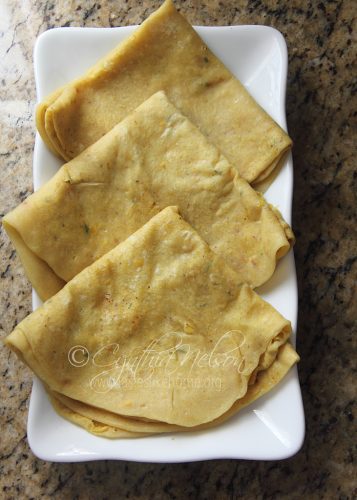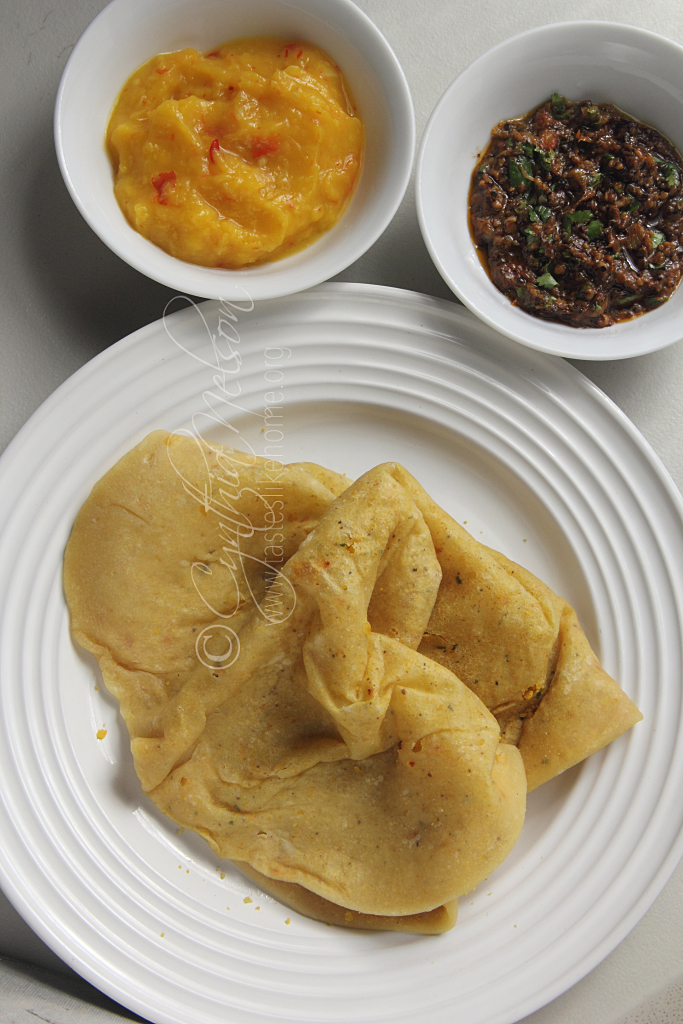 Last week Saturday, I made the best Dhal Puri I have ever made.
Last week Saturday, I made the best Dhal Puri I have ever made.
Taste has never been an issue for me; I had mastered that, but I never seemed to get it as paper thin as I liked even though I would roll it thin. Not so this time, it was thin and soft, just as I like it.
There are some things that we home cooks and bakers get obsessed about perfecting and getting just the way we want, like and prefer them. Cook-up rice, Fried rice, Paratha/oil roti, bread, Tennis rolls, and black cake are among such things, and right up there with them is Dhal puri. Perfecting is about getting the cook just right, and that could be the temperature, taste (flavour), balance, texture and finish. With the dhal puri, for me it was about the texture and the finish. I finally managed to achieve them by adjusting the cooking temperature and borrowing two methods from Mauritius’ dhal puri – eliminating baking powder from the dough and using the turmeric flavoured water in which the split peas were cooked, to make the dough.
 Last week when I shared about Mauritius’ gâteaux piment (chilli cakes), a split pea fritter, I said I’d try their version of dhal puri and share the results with you.
Last week when I shared about Mauritius’ gâteaux piment (chilli cakes), a split pea fritter, I said I’d try their version of dhal puri and share the results with you.
The thing that made me most curious about their dhal puri was the use of the water in which the peas were cooked, to make the dough. The lack of baking powder was not surprising because most types of roti(s) from which ours are influenced do not contain any leavening agent. It makes sense since baking powder is a 19th century invention. I went in search of what nutrients or elements might be in the boiled, turmeric hued and flavoured water. It turns out that aquafaba – the water in which chickpeas and other pulses have been cooked – is a composition of carbohydrates, proteins and other soluble plant solids that migrate from the seeds to the water during the cooking process. This combination varies depending on the type of pulse/legume thus providing a range of emulsifying, foaming, binding, gelatinizing and thickening properties. I couldn’t find any information identifying the specific properties that would be in split peas boiled water, but working off of the general composition of aquafaba, one can understand how the quality of the dough would be impacted when combined (with flour). Whether or not scientific thought went into the decision to mix the dhal puri dough with the water in which the peas were cooked, it was an excellent one because there is a soft suppleness to the dough when kneaded and rested. The rich colour of the cooked dhal puri comes from the turmeric that coloured and subtly flavoured the water and peas.
I set about making the dhal puri seasoning it as we would, with garlic, hot pepper and freshly ground cumin/geera. I like to add some finely chopped coriander/cilantro to my filling. Mauritius’ dhal puri filling, based on all the recipes and videos I looked at, optionally added ground geera and not as much as we would. I think that because theirs is always served as a wrap with a wide variety of fillings, from chutneys to pickled vegetables and vegetable curries, they keep the puri filling light. So apart from the two obvious things I have mentioned – no baking powder added to the dough and kneading with the cooked peas-water, here are the other things I did that resulted in my upping my dhal puri-making game.
● I rested the dough for more than 30 minutes. I let it sit for an hour. However, I think that the dough is ready to be filled at the end of 30 minutes.
● Once all the dough balls were filled, I immediately began the process of cooking the dhal puri, starting with the first one that was filled. It would have gotten adequate resting time as I was filling the others.
● Each dhal puri was rolled very thin with several light dustings of flour to ensure that it did not stick to the surface on which it was rolled.
● The tawah was heated on medium and then I dropped the temperature to low to cook the roti. This was another game changer for me. I did not want any cooked brown spots on my puri and cooking it on low heat did the trick. The thing is though, be sure to fully heat the pan on medium heat before reducing it to low. That way, the heat stays steady.
● I lightly brushed the heated tawah with oil before adding the first dhal puri to cook. I have seen a lot of people do this but this was the first time I tried it. Honestly, I do not know if it makes a difference but I did it anyway.
● As soon as the dhal puri turned opaque indicating that the first side had been cooked (which took about 30 seconds), I flipped the dhal puri and brushed it with oil and then immediately flipped it again and brushed the other side. The entire cooking process took a minute to a minute and a half.
As I finished cooking each dhal puri, folding it on the tawah and transferring to a lined bowl, I was amazed at what I was seeing and felt very pleased with my achievement. The dhal puri(s) never swelled while cooking (no baking powder). While they looked soft at the end of the cooking process, the proof for me was going to be in the tearing and eating of the dhal puri. The chew.
The warm dhal puri was soft to the touch, thin, and tore easily, some of the filling spilling onto my plate, just the way I like it. I tore and ate 2 pieces by themselves to assess the taste, texture, flavour and mouth feel. They were spot on. Eating the torn pieces of dhal puri dripping with curry gravy was pure bliss.
Another test for this dhal puri was going to be in the reheating. Was it still going to be soft when reheated or would it or would it get stiff? Once reheated, the dhal puri was as fresh and soft as the day I made them. To reheat dhal puri, aloo roti and paratha/oil roti, I wrap them individually in parchment paper then aluminium foil and place them in a steamer in a covered pot. When done, I leave them wrapped and carry them to the table, unwrapping only when ready to eat.
Going forward, this is how I am going to be making my dhal puri; no baking powder, dough mixed with water from cooked peas, dough rolled very thin, and the puri cooked on low heat. You learn something every day.
Give it a try and let me know how it works for you.
Cynthia
cynthia@tasteslikehome.org









